Grow “up” to make the most of garden areas with limited footprints. Vertical, compact plants and shrubs like the following add height, color and texture that can make city lots, decks, patios, containers and small yards look larger.
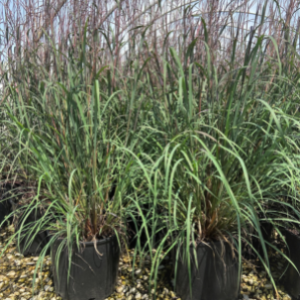
Blackhawks Big Bluestem (Andropogon gerardii)
Blackhawks Big Bluestem
With a garden height of 5 feet and spread of only 2 feet, Blackhawks Big Bluestem is an ideal specimen plant near an entryway or privacy screen near a patio. Deep green foliage emerges in spring, then matures to purple in summer and black in fall. Plant this bluestem in a larger container as “thriller” and use for height in cut floral arrangements.
Blackhawks Big Bluestem is easy to grow and requires very little care. It is drought tolerant and thrives in average to poor soil conditions. Native to North America, this bluestem likes full sun and has no special watering needs. Plant in USDA Hardiness Zones 3 to 9.
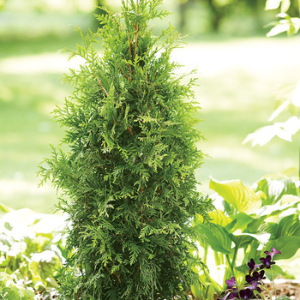
Spring Grove® Western Arborvitae (Thuja plicata) – Proven Winners photo
Spring Grove® Western Arborvitae
If you’re looking for a shrub that checks all the boxes on versatility – it’s Spring Grove® Western Arborvitae. This evergreen grows quickly in the landscape to a maximum height of 30 feet and width of 12 feet. It retains its glossy, dark green color in four seasons. This arborvitae is an excellent choice in commercial or residential landscape designs. It works well as a garden star, backdrop in perennial beds and privacy screen.
Spring Grove® Western Arborvitae is hardy to -25 degrees. It is deer resistant and drought tolerant. Moderate maintenance includes light pruning in fall. Apply a slow release fertilizer designed for evergreens in early spring. Plant in USDA Hardiness Zones 5 to 8.
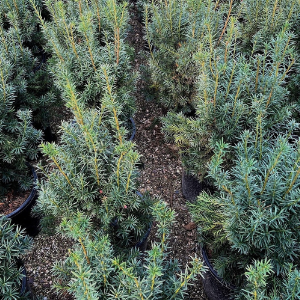
Hicks Yew (Taxus x media ‘Hicksii’)
Hicks Yew
A columnar evergreen shrub that pairs well with lilacs, weigela and spirea, Hicks Yew works well as a privacy screen, foundation plant and doorway accent at commercial and residential entryways. Upright branches have dense, dark green foliage and produce ornamental red arils in early fall.
This slow-growing yew rises to 12 feet tall and has a 4-foot spread at maturity. It requires regular watering, especially during dry hot spells. Apply an all-purpose plant food to the soil in early spring. Birds and other small animals like yews for nesting and protection. Of special note is that Hicks Yew seeds within its arils are poisonous if consumed by humans, dogs and other animals. However, deer and birds are unaffected. Plant in USDA Hardiness Zones 4 to 7.
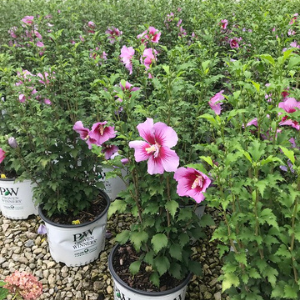
Purple Pillar® Rose of Sharon (Hibiscus syriacus)
Purple Pillar® Rose of Sharon
Purple Pillar® Rose of Sharon has a compact, columnar shape and smaller size that is unique among its counterparts. This award-winning plant grows to a maximum height of 16 feet and width of only 3 feet. Perfect alone for a little privacy or in groupings for more, this rose of Sharon offers long-blooming color to boot. Use as hedge plantings, in containers and as patio borders.
Striking purple and deep-pink petals with yellow centers bloom up and down each vertical stem from summer through fall. Purple Pillar® Rose of Sharon attracts pollinators and resists deer. It is easy to care for and requires little to no pruning. Place in soil with good drainage and in full sun. Plant in USDA Hardiness Zones 5 to 9.
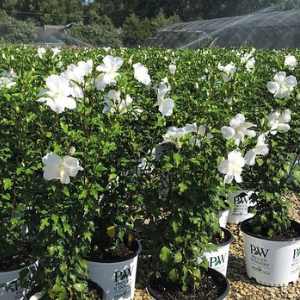
White Pillar® Rose of Sharon (Hibiscus syriacus)
White Pillar® Rose of Sharon
A sister to Purple Pillar® Rose of Sharon, White Pillar® Rose of Sharon has similar characteristics. Prized for its shape, it takes up far less space in the garden than other varieties. Like its sister, it features semi-double blooms, providing two or more layers of continuous white petals that complement other flowers in the garden and shimmer at night.
Bloom time is summer through fall, on new wood. Add a 3-inch layer of bark mulch to the root zone and, if desired, prune in early spring and apply a granular fertilizer formulated for woody plants. Select White Pillar® Rose of Sharon if you’re looking to add a stylish, vertical shrub to your smaller landscape. Plant in USDA Hardiness Zones 5-9.
Our healthy plants are grown to meet the diverse needs of Midwest landscapes. See Loma Vista Nursery’s plant catalog for more information.
Learn More About Plants from Loma Vista Nursery!
Loma Vista Nursery’s staff members are experts in the field. We love helping people learn and understand more about healthy plants that perform well in Midwest landscapes. Feel free to email us at sales@lomavistanursery.com or call us at (785) 229-7200 to get help with your plant-related questions.
Connect with us!
Stay up-to-date on our plant recommendations, growing tips, and more by following us on social media.
